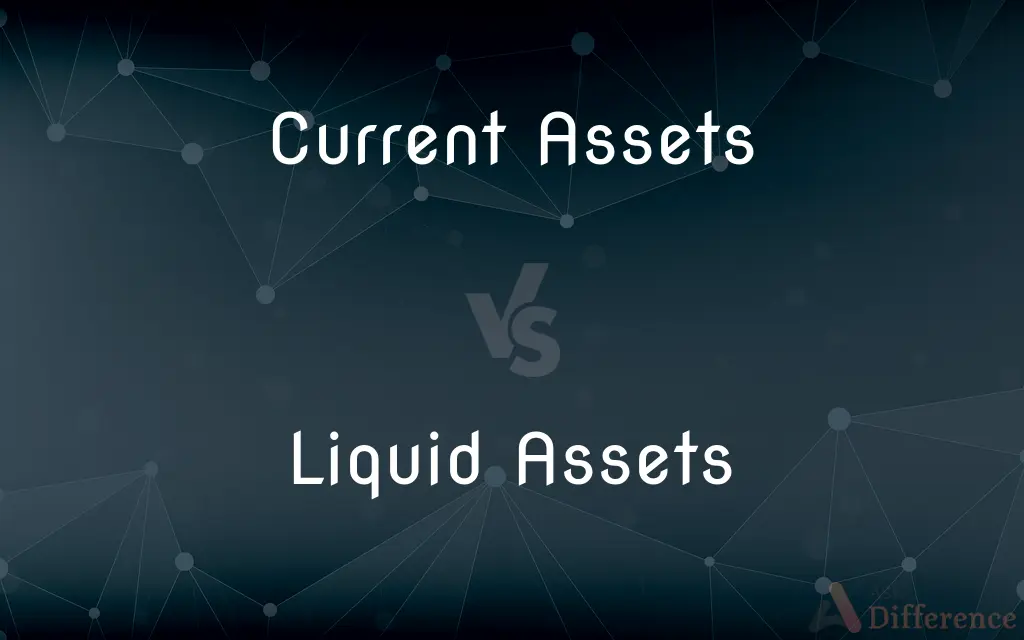Current Assets vs. Liquid Assets — What's the Difference?
By Tayyaba Rehman — Published on October 14, 2023
Current Assets are assets expected to be used or converted into cash within one year, while Liquid Assets are assets that can be quickly converted to cash without losing value.

Difference Between Current Assets and Liquid Assets
Table of Contents
ADVERTISEMENT
Key Differences
Current Assets and Liquid Assets both play integral roles in assessing a company's financial health, albeit with distinct differences in liquidity and usage timeframes. Current Assets encompass assets that are expected to be utilized or converted into cash typically within one fiscal year, which can include cash, accounts receivable, and inventory. Liquid Assets, however, strictly refer to assets that can be promptly converted into cash or are already in cash form, such as cash and cash equivalents, underscoring a high degree of liquidity.
In evaluating short-term financial robustness, Current Assets provide a broader view by including assets that may have varying degrees of liquidity, while Liquid Assets offer a more constricted and immediate perspective of assets that are readily available for use. While Current Assets include all Liquid Assets, not all Current Assets are considered Liquid Assets because not all of them can be quickly converted to cash without losing value. For instance, inventory (a current asset) may not be as liquid as a Treasury bill (a liquid asset).
When gauging a company's ability to meet its short-term obligations, the distinction between Current Assets and Liquid Assets becomes salient. Current Assets are utilized in calculating financial ratios like the current ratio, which assesses a company's capability to cover short-term liabilities. Meanwhile, Liquid Assets are pivotal in understanding how equipped a company is in navigating through financial exigencies, given their immediate convertibility to cash.
Understanding the nuances between Current Assets and Liquid Assets facilitates prudent financial management and decision-making. While managing Current Assets, consideration of various elements like credit management and inventory turnover becomes essential. In contrast, managing Liquid Assets demands a focus on ensuring that the company maintains enough readily accessible resources to adeptly manage unforeseen financial needs without compromising operational functionality.
Comparison Chart
Liquidity
Varying degrees of liquidity
High liquidity, easily converted to cash
ADVERTISEMENT
Types
Includes cash, accounts receivable, etc
Primarily cash and cash equivalents
Use in Financial Ratios
Used in calculating the current ratio
Not specifically used in common ratios
Time Frame
Expected to be used within one year
Can be used immediately
Example of Non-Overlap
Inventory is a Current Asset
Inventory is not typically a Liquid Asset
Compare with Definitions
Current Assets
Resources expected to be used in the operational cycle.
The company’s Current Assets were assessed for working capital management.
Liquid Assets
Highly liquid current assets.
The Liquid Assets were assessed for ensuring liquidity maintenance.
Current Assets
Assets expected to be converted to cash within a year.
The firm’s Current Assets include cash and inventory.
Liquid Assets
Financial assets that can be quickly monetized.
Adequate Liquid Assets were deemed crucial for unexpected expenditures.
Current Assets
Assets that are either cash or expected to be cash soon.
A significant portion of the Current Assets was held in marketable securities.
Liquid Assets
Assets that can be rapidly converted to cash.
The company’s Liquid Assets were considered during emergency planning.
Current Assets
Assets utilized or turned to cash in the short term.
Current Assets, like accounts receivable, were scrutinized for liquidity analysis.
Liquid Assets
Assets in cash or close-to-cash form.
Liquid Assets, like money market funds, were readily available for use.
Current Assets
Short-term assets meant for operating activities.
The ratio of Current Assets to liabilities was analyzed for solvency.
Liquid Assets
Resources easily convertible to cash without losing value.
Ample Liquid Assets enabled the firm to navigate through financial crises.
Common Curiosities
What are Current Assets?
Current Assets are assets that are expected to be used or turned into cash within one fiscal year.
Why are Current Assets important?
Current Assets are vital to meet short-term liabilities and support the operating cycle of a business.
How are Current Assets and Liquid Assets reflected in financial statements?
Current Assets appear in the balance sheet, while Liquid Assets are a subset of them, including items like cash and cash equivalents.
What role do Liquid Assets play in a company?
Liquid Assets provide a cushion for meeting unforeseen expenses or taking advantage of sudden opportunities.
How do Current Assets impact working capital?
Current Assets are a key component of working capital, which is essential for day-to-day operations and short-term financial health.
Can a company have high Current Assets and low Liquid Assets?
Yes, a company might have high Current Assets like inventory and receivables, but lower Liquid Assets like cash and marketable securities.
Why might a company prioritize having ample Liquid Assets?
Ample Liquid Assets enable a company to manage unplanned expenses or capitalize on unexpected opportunities without external financing.
Are all Current Assets also Liquid Assets?
No, while all Liquid Assets are Current Assets, not all Current Assets (e.g., inventory) are considered Liquid Assets.
How do Liquid Assets differ from fixed assets?
Unlike fixed assets, Liquid Assets can be swiftly and easily converted to cash without significant loss.
How does management of Current Assets affect operational efficiency?
Effective management of Current Assets, like maintaining optimal inventory levels, can enhance operational efficiency and profitability.
What defines Liquid Assets?
Liquid Assets are assets that can be quickly converted to cash without a significant loss in value.
Can an asset be both current and non-liquid?
Yes, an example is inventory, which is a Current Asset but may not be easily or quickly convertible to cash, thus not typically a Liquid Asset.
What is the role of Liquid Assets in financial emergencies?
Liquid Assets provide financial security during emergencies by offering readily available funds.
How do companies manage Liquid Assets efficiently?
Efficient management of Liquid Assets involves maintaining adequate cash for needs without unnecessarily tying up capital.
How can an increase in Current Assets affect cash flow?
An increase in Current Assets, such as accounts receivable or inventory, can potentially tie up cash and impact cash flow negatively.
Share Your Discovery

Previous Comparison
LED TV vs. Plasma TV
Next Comparison
Chaos vs. ComplexityAuthor Spotlight
Written by
Tayyaba RehmanTayyaba Rehman is a distinguished writer, currently serving as a primary contributor to askdifference.com. As a researcher in semantics and etymology, Tayyaba's passion for the complexity of languages and their distinctions has found a perfect home on the platform. Tayyaba delves into the intricacies of language, distinguishing between commonly confused words and phrases, thereby providing clarity for readers worldwide.













































